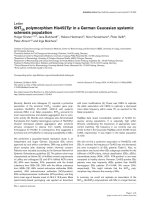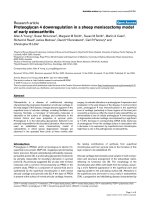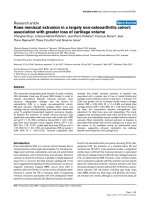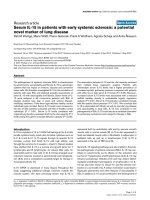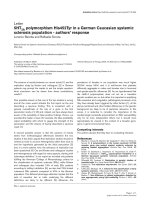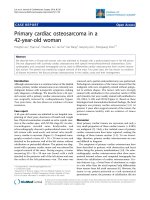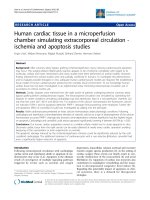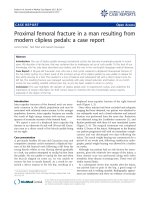Báo cáo y học: "5HT2A polymorphism His452Tyr in a German Caucasian systemic sclerosis population - authors’ response" docx
Bạn đang xem bản rút gọn của tài liệu. Xem và tải ngay bản đầy đủ của tài liệu tại đây (40.25 KB, 1 trang )
Available online />Page 1 of 1
(page number not for citation purposes)
The variance of results between our recent article [1] and the
replication study by Kirsten and colleagues [2] in German
patients may prompt the reader to ask the simple question:
what conclusion can be drawn from these contradictory
results?
One possible answer is that one of the two studies is wrong
and all the clues would indicate the first report as the one
describing a spurious finding. This is consistent with a
general overestimate of the role of a gene in the first
association study of it [3] and, indeed, we have always been
aware of the possibility of false positive findings. Hence, we
provided the reader a mean (for example, the false probability
report probability) with which to gauge the strength of the
association and the chance of having described a spurious
result [1].
A second possible answer is that the variance of results
stems from methodological differences between the two
studies. It has been argued that replication studies should be
viewed as tools to uncover heterogeneity rather than tools to
test the hypothesis generated by the initial association [3]
and, in a more extreme view, the relevance of replication has
been questioned [4]. Our and Kirsten and colleagues’ studies
are heterogeneous with regard to many aspects, starting with
‘phenotype definition’. In our report we included only patients
fulfilling the American College of Rheumatology criteria for
the classification of systemic sclerosis (SSc), while Kristen
and colleagues also included 19% of early SSc patients
according to LeRoy’s definition [5]; we also had 75% limited
cutaneous SSc patients compared to 50% in the German
population. This different phenotype definition implies that the
sets of causative loci or traits underlying the different
definitions are likely to be different [3]. Moreover, the
prevalence of females in our population was much higher
(93.9% versus 50%) and it is well-known that platelets
differently aggregate in males and females due to hormonal
and gender-specific influences [6]. As we hypothesized that
the rs6314 polymorphism does not act as a causative
genetic mutation per se, but rather it is important in amplifying
SSc-causative and coagulative pathological processes once
they have already been triggered by other factors [1], all the
above-mentioned and other hidden differences in the genetic
background are likely to be of particular relevance. In this
sense, it is reductive to consider the importance of the
studied single nucleotide polymorphism on SSc susceptibility
only for its main independent effect, but it should more
appropriately be viewed in the context of a broader gene-
gene or gene-environmental frame.
Competing interests
The authors declare that they have no competing interests.
References
1. Beretta L, Cossu M, Marchini M, Cappiello F, Artoni A, Motta G,
Scorza R: A polymorphism in the human serotonin 5-HT2A
receptor gene may protect against systemic sclerosis by
reducing platelet aggregation. Arthritis Res Ther 2008, 10:
R103.
2. Kirsten H, Burkhardt J, Hantmann H, Hunzelmann N, Vaith P,
Ahnert P, Melchers I: 75HT
2A
polymorphism His452Tyr in a
German Caucasian systemic sclerosis population. Arthritis
Res Ther 2009, 11:403.
3. Sillanpää MJ, Auranen K: Replication in genetic studies of
complex traits. Ann Hum Genet 2004, 68:646-657.
4. Vieland VJ: The replication requirement. Nat Genet 2000, 29:
244-245.
5. LeRoy EC, Medsger TA Jr: Criteria for the classification of early
systemic sclerosis. J Rheumatol 2001, 28:1573-1576.
6. Haque SF, Matsubayashi H, Izumi S, Sugi T, Arai T, Kondo A,
Makino T: Sex difference in platelet aggregation detected by
new aggregometry using light scattering. Endocr J 2001, 48:
33-41.
Letter
5HT
2A
polymorphism His452Tyr in a German Caucasian systemic
sclerosis population - authors’ response
Lorenzo Beretta and Raffaella Scorza
Referral Center for Systemic Autoimmune Diseases, IRCCS Fondazione Policlinico-Mangiagalli-Regina Elena and University of Milan, Via Pace, 20122,
Milan, Italy
Corresponding author: Raffaella Scorza,
Published: 26 March 2009 Arthritis Research & Therapy 2009, 11:404 (doi:10.1186/ar2635)
This article is online at />© 2009 BioMed Central Ltd
See related research by Beretta et al., and related letter by Kirsten et al.,
/>SSc = systemic sclerosis.
